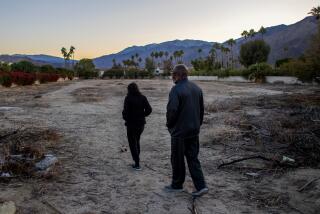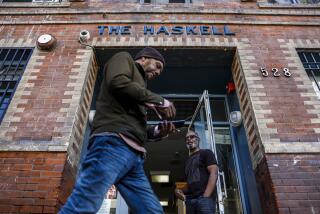Detroit Residents Abandon the Legalities in Trying to Save Decaying Neighborhood
- Share via
DETROIT — Finally, Delores Strouse got fed up.
The abandoned and decaying clapboard house at 15709 Chatham St. on Detroit’s west side, which stood just two doors from her home, had become a haven for prostitution and drug trafficking. For nearly two years, Strouse and others in her working-class neighborhood had been complaining to city officials, pleading with them to tear the house down.
But for nearly two years, the city had ignored them, and 15709 Chatham, like thousands of other abandoned buildings throughout Detroit, kept falling into worse and worse repair. By this summer, 15709 Chatham had become little more than a wooden shell, with its doors and windows long gone, its walls riddled with gaping holes.
So on Saturday, July 1, Strouse decided she could wait no longer.
She got a hammer and started tearing the house down.
Then she went up and down the block, recruiting neighbors to come with their sledgehammers and help her.
Soon, 15709 Chatham was gone, its debris piled high on the sidewalk, and five of the neighbors were under arrest for “wrecking without a license.” Just as quickly, Delores Strouse and her friends had become inner-city folk heroes.
“The only reason we got arrested,” says Michael Gardner, Strouse’s fiance, “was because we were putting down City Hall too much. We got too much publicity.”
Case Strikes Nerve
Indeed, the grass-roots demolition on Chatham Street and the court case against those involved has struck a raw nerve in a city that is undergoing an unusual crisis.
Just as most other major American cities are becoming increasingly congested and their residents are fighting to stave off further growth, Detroit is being plagued by the opposite problem--a large-scale population exodus to distant suburbs, and a resulting explosion in the number of vacant and abandoned homes and buildings dotting its landscape.
With an estimated 15,000 vacant buildings now standing in the city--and an additional 2,000 being abandoned each year--city officials have come under heavy fire from residents for the agonizingly slow pace of their abandoned building demolition program.
According to a series on Detroit’s abandoned building crisis in the Detroit Free Press this week, it currently takes roughly 20 months from the time neighbors complain about a hazardous building to the time the city demolishes it; in the meantime, many are transformed into crack houses, bringing violent crime to previously stable neighborhoods.
Often, feuds between rival drug gangs lead to crack house torchings, so that many abandoned buildings end up as burnt wrecks long before the city’s demolition crews can get to them.
As a result, residents like those on Chatham Street have been taking matters into their own hands. In the most controversial case, two men were acquitted of arson last year after having burned down a flourishing neighborhood crack house in 1987 in order to get the drug dealers out of their area.
Now, the city’s enormous inventory of abandoned buildings has become a major political issue in the midst of this year’s mayoral race. The Chatham Street case has become an embarrassment for Detroit Mayor Coleman A. Young, who is seeking an unprecedented fifth term this fall.
Young publicly condemned the action by the Chatham Street neighbors, saying the residents had “broken at least 10 laws” and thus should be punished. But his opponents contend that the case shows how many long-suffering residents have lost patience with his Administration.
“It was frustration,” says Debbie Davidson, another person who was arrested on Chatham Street. “We kept calling the city and they kept delaying, and we were tired of their lies about when they were going to tear it down. Finally, we had a group of people around, and one thing led to another and we started tearing it down.”
“I’m not saying it was right, and I’m not saying it was wrong, but if the city isn’t doing something, then the people have to do it themselves,” Gardner added. “This was our way to get the city to get to work.”
“I’ve had people tell me they’d do the same thing if they had an abandoned building next to them,” said Robert Spangler, another neighbor arrested for the Chatham Street demolition.
Now, only a pile of dirt remains where 15709 Chatham stood--a city contractor has bulldozed what was left over after the neighbors were through--and people on the street say that their children already feel safer.
“I did it because kids were getting hurt there and they were scared to walk down the street,” said Delores Strouse, watching as a group of small children played on the mound of dirt where the house had been.
“Now, this is more of a neighborhood.”
More to Read
Sign up for Essential California
The most important California stories and recommendations in your inbox every morning.
You may occasionally receive promotional content from the Los Angeles Times.










